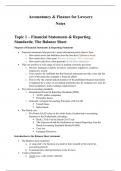Summary
Accountancy & Finance for Lawyers - Full Course Summary
- Course
- Institution
This document provides a full summary for the Accountancy & Finance for Lawyers course for Global Law students. It is the perfect course companion, containing explanations of all of the relevant concepts in accounting and finance, as well as all of the formulas you will need for the course. The...
[Show more]



